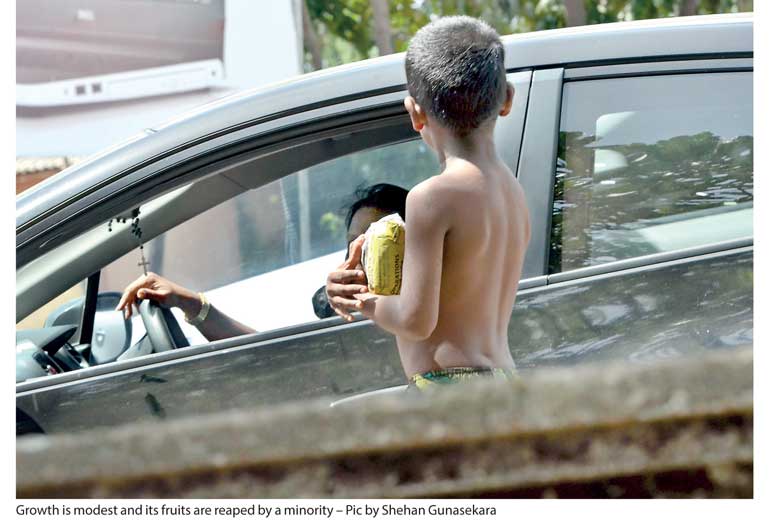Tuesday Apr 22, 2025
Tuesday Apr 22, 2025
Wednesday, 11 October 2017 00:00 - - {{hitsCtrl.values.hits}}
 The Government recently released its ‘Vision 2025’ manifesto, aiming to revive the momentum of pro-market reforms. Its timing coincided with the 40th anniversary of Sri Lanka’s embrace of deregulation, trade liberalisation and privatisation, well ahead of the rest of South Asia.
The Government recently released its ‘Vision 2025’ manifesto, aiming to revive the momentum of pro-market reforms. Its timing coincided with the 40th anniversary of Sri Lanka’s embrace of deregulation, trade liberalisation and privatisation, well ahead of the rest of South Asia.
This shift from State control of the economy to marketisation was rationalised as the only alternative to overcome the fiscal and political malaise between 1970 and 1977, when the terms of trade turned against the island’s primary commodity exports and youth unemployment stoked social unrest.
The ‘open economy’ that evolved after 1977 is now firmly entrenched and has become ‘common sense’ in mainstream politics. The current coalition between Prime Minister Ranil Wickremesinghe’s historically right-wing United National Party (UNP) and President Maithripala Sirisena’s faction of the traditionally left-of-centre Sri Lanka Freedom Party (SLFP) is but one expression of a larger consensus on the path to development and its terminus.
However, there is stubborn resistance among politicians, bureaucrats, academics and lobbyists to honest accounting for past performance following structural adjustment reforms, even as the advocates of neo-liberalism dogmatically demand their intensification.
Indeed an overview of key economic indicators illuminates how the cure has been worse than the disease.
Growth in gross domestic product has been unspectacular, averaging 4.8% between 1978 and 2009, in comparison to 3.5% between 1971 and 1976. Some of this initial expansion was from massive inflows of grants and soft loans.
A third world country with impressive outcomes in literacy, longevity and social welfare, achieved in an era of modest growth, national capitalism and social democratic ideology, was now hailing the virtues of high growth, foreign investment and free market capitalism. Western donors and multilateral agencies were eager to reward its Government, even when State practice diverged from rhetoric.
Average household income has risen rapidly but so too has the concentration of wealth. Inequality has deepened: the gini coefficient that was 0.35 in 1973, worsened to 0.48 by 2012/13. The richest 20% of households command 52.9% of income, more than the rest combined; while the poorest 20% muster only 4.5%. The bottom 40% of the population survive on under $ 2.50 per day.
Inflation has often runaway into double digits, whereas before 1970 it was under 3%, as the cost of living spirals and household debt escalates.
Manufactured goods have soared in share of exports from 13.4% in 1977 to 77% in 2016; but are dominated by  ready-made apparels, which have negligible local value addition.
ready-made apparels, which have negligible local value addition.
Industries that profited from textile and clothing quotas, duty-free inputs, tax holidays, free infrastructure, subsidised services and lax environmental and labour regulations, still depend on imports of raw and semi-finished materials. This impedes linkages in the local economy and gobbles net foreign exchange earnings.
Export-oriented industrialisation is promoted as the cure-all for all ills. Its labour force is mostly of women in low waged and highly exploitative conditions; and where unions are not allowed to organise inside and outside the export processing zones.
Employment in this sector has only reached over 470,000 or under 6% of the labour force. This is the same number as those who leave every two years for foreign employment. Economic reforms have failed to create decent and secure jobs.
Agriculture has drastically declined in economic share to 7.1% in 2016 from 35.1% in 1970-71; and in export composition to 22.6% in 2016 from 94.6% in 1970-71. Still it matters in livelihoods, as over 70% of the population is rural and as marginally more are employed in agriculture (27.1%), than in industry (26.4%).
There has been limited diversification here too: tea, rubber and coconut predominate, as before 1977. Revenue from tea, plucked mostly by women, has slumped to third-place in export income. In comparison, migrant remittances of mainly women in domestic work in the Middle East amounted to nearly $ 7 billion last year or almost equal to earnings from textiles, tourism and tea combined.
Women’s work is the basis of the monetised and care economy but their labour force participation rate has plateaued at under 36% or less than half that of men.
Sri Lanka’s main food imports of wheat flour, rice, sugar, milk and milk products and fish and fish products are unchanged. Unsurprisingly demand for food has risen along with population increase and household income.
The rupee is currently trading at Rs. 153 to one US dollar (whereas it was Rs. 8.60 in 1977) but with no corresponding gain in export volumes and earnings. In 2015, income from exports only equalled 55% of the cost of imports, widening further the balance of payments deficit.
Chronic under-investment in food production has intensified dependence on imports and also insecurity as consumers are more exposed to world market price fluctuations. The withdrawal of state support in access to credit, inputs and extension services as well as in direct purchase, storage, transport and distribution has abandoned producers to predatory middlemen, aggravating agrarian distress.
All regimes have bridged the chasm between income and expenditure with loans. External debt has ballooned to $ 46.6 billion (from under $ 942 million in 1976), diverting resources from public spending to debt-servicing.
Foreign Direct Investment last year was only $ 898 million, whereas foreign loans totalled $ 1.287 billion. This has been the pattern throughout despite generous incentives to private capital and wage repression in the export sector.
Often, Sri Lanka’s disastrous internal war between 1983 and 2009 is blamed for its sluggish economic performance. In fact its economic impact was diffuse, as export production of goods and crops was outside the conflict zone. Rather it was during the southern youth insurrection of 1987-1989 – itself a reaction to conspicuous inequalities post-liberalisation – that the economy took its worst battering until 2001.
The ‘Vision 2025’ promise of “inclusive and equitable growth and development” is deceitful. It recycles the same market fundamentalist ideology that was supposed to answer the worries of the economy. Instead, 40 years later it is apparent, to those who wish to see, that economic fundamentals are frailer and not stronger than before.
Growth is modest and its fruits are reaped by a minority. Inflation has not been kept under control and reached 7.9% in August, eroding the purchasing power of consumers. Industrialisation has failed to take-off and propel local manufacturing that could expand the home market and save on foreign exchange outflows. Agriculture is disregarded as a means to rural wellbeing and food security, but intended only to cultivate what cannot be eaten.
There was, and is, no deluge of inward foreign direct investment to stimulate production and employment. The debt mountain grows without remorse condemning future generations to live fearfully in its shadow. Gender norms that discriminate against women, including in their entry and equitable participation in the labour force, have not been substantially eroded within the ‘open economy’. Indeed, the withdrawal of social welfare provisioning, and the decline of stable employment, has only intensified the burden heaped upon women.
The development model followed by successive regimes since 1977 has failed. Is it not past overdue to find one that works for the many, and not the few?
[The writer is with the Social Scientists’ Association (SSA). A shorter version appeared in The Hindu on 4 October.]
Discover Kapruka, the leading online shopping platform in Sri Lanka, where you can conveniently send Gifts and Flowers to your loved ones for any event including Valentine ’s Day. Explore a wide range of popular Shopping Categories on Kapruka, including Toys, Groceries, Electronics, Birthday Cakes, Fruits, Chocolates, Flower Bouquets, Clothing, Watches, Lingerie, Gift Sets and Jewellery. Also if you’re interested in selling with Kapruka, Partner Central by Kapruka is the best solution to start with. Moreover, through Kapruka Global Shop, you can also enjoy the convenience of purchasing products from renowned platforms like Amazon and eBay and have them delivered to Sri Lanka.
Discover Kapruka, the leading online shopping platform in Sri Lanka, where you can conveniently send Gifts and Flowers to your loved ones for any event including Valentine ’s Day. Explore a wide range of popular Shopping Categories on Kapruka, including Toys, Groceries, Electronics, Birthday Cakes, Fruits, Chocolates, Flower Bouquets, Clothing, Watches, Lingerie, Gift Sets and Jewellery. Also if you’re interested in selling with Kapruka, Partner Central by Kapruka is the best solution to start with. Moreover, through Kapruka Global Shop, you can also enjoy the convenience of purchasing products from renowned platforms like Amazon and eBay and have them delivered to Sri Lanka.